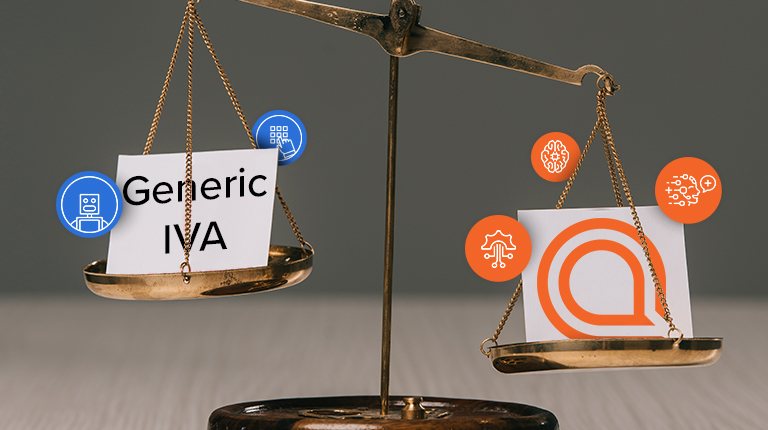How to assess your organization’s ability to fully harness the power of an IVA
Today’s Intelligent Virtual Assistants (IVAs) bring an effortless ease and human-like interaction to customer service. Customers can resolve issues in less time on the channel they prefer, while contact centers reduce live agent minutes, average handle times, and costs. Yet, before implementing a modern IVA solution, organizations should consider if they have the right elements in place to best optimize an IVA.
With any technology that can revolutionize a critical business function – in this case, customer service — it pays to have the right foundation in place. How can you tell if your company is well-prepared to harness the full value of an IVA? Let’s look at 5 hallmarks of IVA readiness. (Spoiler alert: We also have a quick interactive assessment you can take — you’ll find the link at the end of this blog.)
1. Customer-centric culture
Customers are 2.4 more likely to show brand loyalty when they are able to solve their problems quickly, according to Forrester. Putting customers first is the most important factor to optimizing an IVA. The goal and guiding operational principle for an IVA is to provide seamless, nearly effortless service across the channels your customers find most convenient. Because when it’s easy to do business with you, customers will stick around.
The additional benefits — such as lower opex costs and improved scalability for peak times — are of course critical to achieving ROI and ongoing value. However, the success of your IVA will depend on if it’s serving your customers well by understanding their intent and helping them complete their tasks in a self-service manner that lets them move on with their day.
2. A CRM in place (or in the works)
Companies using a customer relationship management (CRM) system are already making strides toward customer-centricity. Designed to manage a company’s interactions with current and potential customers, a CRM consolidates customer information and tracks interactions to enhance customer service and sales. A CRM is critical to IVA success because it helps fuel personalization.
An IVA that can tap into your CRM is able to proactively offer intents, recognizing that the customer has a payment due soon or that they have a shipment that’s on its way. IVA-CRM integration can also be used to offer personalized upsell and cross-sell recommendations, allowing businesses to not just lower costs in the contact center but increase its revenue potential.
3. Specific IVA goals
Companies that see the most benefit from an IVA know the exact gaps in their current systems that they wish to fill, what their customers need but are lacking when it comes to self-service, and the contact center efficiencies that they seek. This knowledge starts with a thorough assessment of your current environment. Some questions you can ask include:
- Do customers have a smooth experience when switching service channels (e.g., from chat to voice or from IVA to live agent) or must they repeat their issue and information?
- What is your current First Call Resolution rate?
- Are you tracking Customer Effort scores?
- What is your current IVA (or IVR) intent accuracy rate?
- Does your IVA integrate smoothly (or at all) with your CRM and other key systems, such as loyalty programs and point-of-sale?
- Are there more complex intents that you’d like to automate that your current system can’t handle?
- Do your current systems stumble when it comes to accents and background noise?
- Are there newer customer service channels, such as social, smart speakers, SMS, or mobile, that you’d like to explore while still keeping service cohesive across channels?
4. Thirst for data-driven improvement
If your organization is already on the data-driven improvement path, an IVA with more robust analytics can fuel further change. When every call is recorded (with private information redacted) through an IVA that provides thorough analytics, it equips your organization with insights that can have far-reaching potential for improving your overall customer service strategy. You can identify trending issues, evolve the IVA to address new intents, and bring this knowledge to other functions, such as product development, your digital team, or warehouse and shipping.
5. A trailblazing approach to technology
Today’s IVAs are a far cry from more nascent automated service technology that frustrated customers cringe at, like automated voice systems with lengthy menus or chatbots that mostly regurgitate FAQ links. Interactions IVAs, for example, are powered by Automatic Speech Recognition (ASR), Natural Language Processing (NLP), dialog management, machine learning, and Adaptive Understanding™, which seamlessly blends AI and human understanding in real time for superior accuracy.
Our clients enjoy being on the forefront of customer-centric technology, thanks to Interactions rigorous R&D, which has resulted in 131 patents and counting. And clients have the flexibility to pursue their goals using our modular and scalable platform, which makes it simple to combine services to optimize and differentiate your IVA. Those companies that already have an agile, open, and innovative attitude toward technology will be well positioned to take full advantage of this flexibility.
These are just a few of the elements that make up an IVA-ready organization. To learn where your organization lands on our IVA Maturity scale, take our 60-second assessment.




